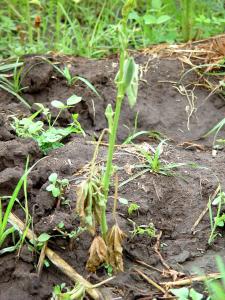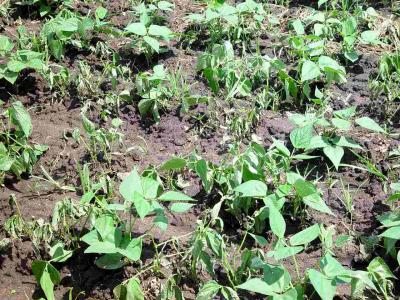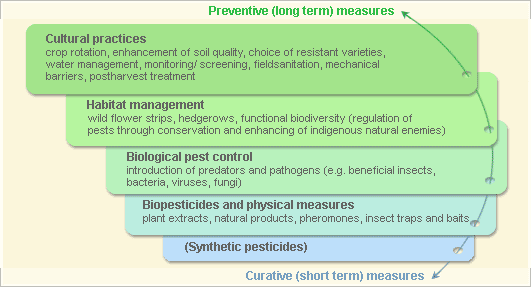Geographical Distribution in Africa
Geographical Distribution of Fusarium wilt in Africa (red marked). Updated on 10 July 2019. Source CABI.
General Information on Disease and Damage
Important Fusarium species:
- Banana wilt (Panama disease) (F. oxysporum f.sp. cubense)
- Cabbage yellows (F. oxysporum f.sp. conglutinans)
- Fusarium wilt of common beans (F. oxysporum f.sp. phaseoli)
- Fusarium wilt of cotton and okra (F. oxysporum f.sp. vasinfectum)
- Fusarium wilt of peas (F. oxysporum f.sp. pisi)
- Fusarium wilt of pigeon pea (F. odum)
- Fusarium wilt of tomato (F. oxysporum f.sp. lycopersici)
Symptoms on banana

An infected plant is characterised by a strong yellowing of the leaves that remain erect for 1 to 2 weeks. Some of the leaves may then collapse at the leaf stalk and hang down at the pseudostem. The leaves fall in order, from the oldest to the youngest, until they hang about the plant like a skirt, and dry up.
The fungus grows in the vascular system causing the plant to wilt. A lengthwise cut on the pseudostem will show numerous brown and black lines running in all directions. Infected suckers growing out of diseased corms (rhizomes) produce plants that wilt and eventually die. Leaf symptoms appear after the fungus has spread through the corm (rhizome). In younger plants, the first signs of infection are to be found on the unfurling leaf which turns yellow and dies off.
Symptoms on cotton and okra (F. oxysporum f.sp. vasinfectum)
 |
| Wilting of okra plant due to Fusarium wilt |
|
© A.M. Varela & A.A. Seif, icipe
|
The affected plants are stunted. The leaves turn yellow, wilt and are later shed. Usually the lower leaves are the first affected. When a stem or the main root is cut crosswise, brown discolouration is usually found in the ring just beneath the bark. Wilting of plants is mostly gradual.
Symptoms on tomato
The lower leaves of the plant usually turn yellow and die. One or more branches may show definite symptoms. Leaflets on one side of a petiole may be affected, while those on another side remain without symptoms. Diseased leaves readily break away from the stem. Sometimes the affected leaves may dry up before wilting is detected.
When affected stems just above the ground level and petioles are cut diagonally, a brown discolouration of the water conducting tissue inside the stem will be seen.
Symptoms on beans
 |
| Fusarium wilt on beans |
|
© A.M. Varela, icipe
|
Infection often occurs on medium-aged or older plants. It begins as a yellowing and wilting of the lower leaves. The infection progresses up the plant until the entire plant turns yellow. Plants become stunted when infected at a younger age.
To be sure that the plant is infected by Fusarium wilt, you make a lengthwise cut on the stem at the soil line, near the base. The cut has a dark-brownish vascular tissue below the bark. If an infected plant is uprooted, the roots are partially or totally reddish-brown in colour.
Affected plant stages
Cotton and Okra: Seedling stage and vegetative growing stage.
Banana: Flowering stage, fruiting stage and vegetative growing stage.
Tomato: Flowering stage, fruiting stage and seedling stage.
Beans: Vegetative growing stage.
Affected plant parts
Cotton and Okra: Leaves, whole plant, and roots
Banana: Growing points, leaves, roots and stems.
Tomato: Leaves, stems, whole plant, and roots.
Beans: Leaves and roots.
Symptoms on affected plant part
Cotton and Okra: Leaves: yellowing lesions; abnormal colours. Whole plant: dwarfing.
Banana: Growing points: dead heart. Leaves: lesions; yellowing; wilting; Roots: rot. Stems: internal discolouration; stem splitting.
Tomato: Leaves yellowing. Stems: internal discolouration. Whole plant: wilt.
Beans: Leaves: yellowing; wilting.


Biology and Ecology of Fusarium Wilt
Source of infection and spread
The fungus is both seed-borne and soil-borne. It may become established in many types of soil, but it is likely to cause most damage on light, sandy soils. It is most active at temperatures between 25 and 32° C. Since the fungus produces resting spores (chlamydospores), it can survive in the soil indefinitely even when no host plants are grown. It can also survive in fibrous roots of weeds such as Amaranthus, Digitaria and Malva. It can spread by movement of infested soil or infected transplants. Acidic soils (pH 5.0 to 5.6) and ammonium nitrogen (ammonium nitrate and urea) promote disease development. Infestation by root-knot nematodes enhances the disease.
Conditions that favour development
- High soil temperatures
- High nitrogen levels in the soil
-
Soil moisture stress
- Fusarium infested soil
Pest and disease Management
Pest and disease Management: General illustration of the concept of Infonet-biovision

This illustration shows the methods promoted on infonet-biovision. The methods shown at the top have a long-term effect, while methods shown at the bottom have a short-term effect. In organic farming systems, methods with a long-term effect are the basis of crop production and should be of preference. On the other hand methods with a short-term effect should be used in emergencies only. On infonet we do not promote synthetic pesticides.
Further below you find concrete preventive and curative methods against Fusarium wilt.
Cultural practices
Disease prevention and management:
Spraying with fungicide will not control this disease
- Because Fusarium persist several years in soil, a long crop rotation (4 to 6 years) is necessary.
- Avoid using any solanaceous crop (potato, tomato, pepper, eggplant) or other host plants in the rotation. Rotate with cereals and grasses wherever possible.
- Avoid fields with a long history of Fusarium wilt.
- Deeply plough the fields and leave them fallow for 2-3 months, where feasible
- Use certified, disease-free seeds
- Use resistant varieties, e.g. tomatoes: 'Diego', 'Duke', 'Floridade', 'Fanny', 'Fortune Maker', 'Napoli', 'Radja', 'Roma VF', 'Roma VFN' and 'Tengeru 97'. Graft tomato plants on resistant root stocks where available.
- Raise soil pH by applying lime or farmyard manure where soil is acidic. Do not use chicken manure, which is very acidic.
- Control root-knot nematodes. To find out more on root-knot nematodes click here
- Keep fields weed-free
- Regularly irrigate the crop
Information Source Links
- CABI. (2005). Crop Protection Compendium, 2005 Edition. © CAB International Publishing Wallingford, UK. www.cabi.org
- OISAT: Organisation for Non-Chemical Pest Management in the Tropics www.oisat.org
- Reddy, M.V., Raju, T.N., Sharma, S.B., Nene, Y.L. and McDonald, D. (1993). Handbook of Pigeonpea Diseases. Information Bulletin N. 42. ICRISAT. ISBN: 92-9066-277-8
- Varela, A.M. and Seif, A.A. (2004). A Guide to IPM and Hygiene Standards in Okra Production in Kenya. ICIPE. Kenya. ISBN: 92 9064 161 5
- Varela, A.M., Seif, A.A. and Löhr, B. (2003). A Guide to IPM in Tomato Production in Eastern and Southern Africa. ICIPE. Kenya. ISBN: 92 9064 149 5

